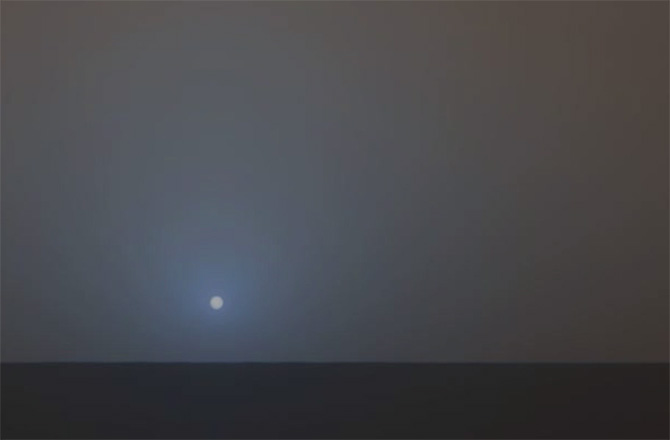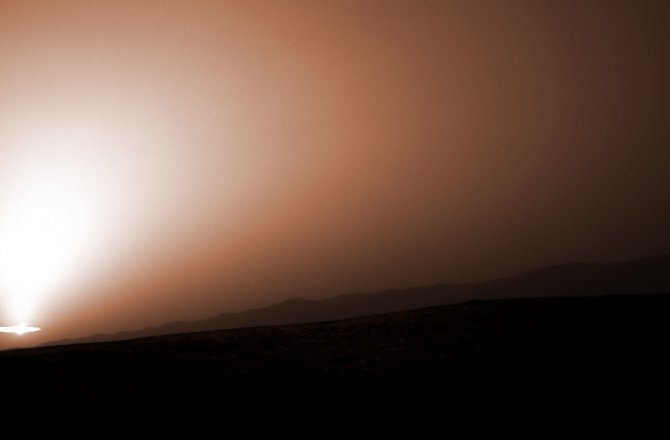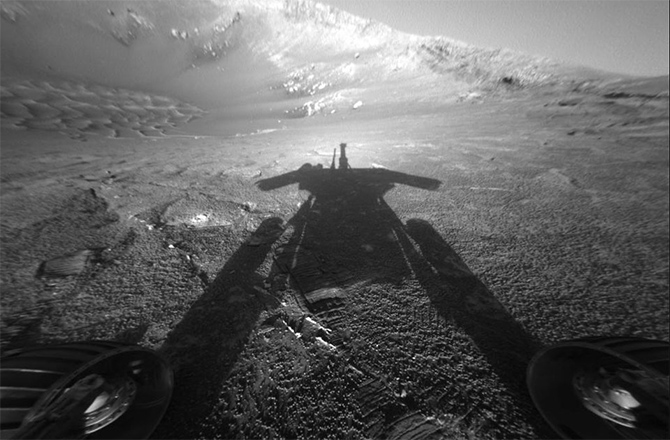.

VIKING 1, AUGUST 1976
Watching a sunset on Earth can be a dazzling and beautiful natural wonder. But what about sunsets on other worlds?
Situated over 50 percent further away from the sun than Earth, there's one planet that we've also had the fortune to see the sun drop below the horizon while standing on the surface -- Mars. However, we have yet to experience this Martian perspective with our own eyes; instead we depend on images beamed to Earth after being witnessed by robotic lenses and CCDs from NASA's landers and rovers.
Our first robotic views of a Martian sunset came from NASA's Viking Program, which set two landers down on the Martian surface in 1976. Viking 1 operated until 1980, whereas Viking 2 survived until 1982. In this observation by Viking 1 across the mission's landing site of Chryse Planitia, one of the lander's many sunsets was imaged 30 Martian days (sols) after touch down. The banding in the sky "is an artifact produced by the incremental brightness levels of the camera," according to NASA.
.

PATHFINDER, JULY 1997
On July 4, 1997, NASA returned to the Martian surface with the Mars Pathfinder mission that consisted of a lander and the first successful Mars rover called "Sojourner." With improved optics, better views of the Martian atmosphere and landscape were possible. Captured on sol 21 of the mission, this view of a sunset behind two prominent hills nicknamed "Twin Peaks" is as striking as it is scientifically important. Pathfinder's lander used its optical instrumentation to measure the dusty particles the setting sunlight was passing through, boosting our understanding of the Martian atmosphere.
.

PATHFINDER SUNRISE
Where there's a sunset, there's also a sunrise. The Pathfinder mission captured this series of photographs just as dawn was breaking over Chryse Planitia on sol 25 of the mission. While the sun was low on the horizon, Pathfinder was also able to image high-altitude clouds of ice glinting in the sunlight.
.

MARS EXPLORATION ROVER SPIRIT, MAY 2005
NASA's Mars rover Spirit captured probably one of the most famous scenes to ever come from Mars. With a bluish inverted triangle of light emanating from a setting sun, giving way to a brownish sky, this view across Gusev Crater captivated the world. The image was captured on the 489th sol after landing on the Red Planet in January 2004. Spirit, along with sister rover Opportunity, had a prime mission of only 3 months. When Spirit photographed this dreamy scene it was already operating a year longer than intended. The rover would continue to explore Gusev Crater until it became stuck in a sand trap in 2009. NASA lost contact with the stranded robot and officially ended its epic adventure in 2010.
.

PHOENIX, SEPTEMBER 2008
The Phoenix Mars Lander was an arctic explorer. Landing in the northern hemisphere's late spring, the solar-powered robot enjoyed 3 months of continuous sunlight at its high latitude location. But as the mission continued, the sun slowly dipped toward the horizon, reducing the intensity of sunlight until it was finally lost. In this series of observations recorded on Sept. 5, 2008, the sun can be seen skirting along the silhouetted horizon, emerging from a lazy sunset into sunrise.
.

MARS EXPLORATION ROVER OPPORTUNITY, NOVEMBER 2010
NASA's Mars rover Opportunity is no stranger to Mars sunsets. Landing on Mars within weeks of its rover twin Spirit, Opportunity continues to doggedly explore Mars to this day. 11 years of continuous operations has taken its toll, but having recently completed the first ever marathon on an alien world, Opportunity is the reigning champion of Mars roving. And with all that roving has come thousands of Mars sunsets and sunrises. This particular view was captured on Nov 5, 2010, when the rover was traversing the plains of Meridiani Planum, heading to its current area of study, Endeavour crater.
.

MARS SCIENCE LABORATORY CURIOSITY, JUNE 2013
Mars rover Curiosity is the newest addition to NASA's ground campaign on the Red Planet. Landing on Aug. 6, 2012, the rover has already provided compelling evidence that the barren planet was once a lot wetter than it is now, also uncovering traces of organic compounds. These historic discoveries provide a tantalizing glimpse into Mars' geological history when it may have been habitable for microorganisms. Although Curiosity is a robotic geologist and chemist, it's also rather good at astronomy. It has also admired the Gale Crater sunsets, not only producing some stunning views with its high-resolution optics, but adding to our scientific understanding of atmospheric composition.
.

MARS SCIENCE LABORATORY CURIOSITY, JUNE 2013
This sequence of photos show Curiosity's view of the sun setting over Gale Crater. The strange bright bands across the sun is caused by the over-saturation of Curiosity's Mastcam CCD pixels, creating a bleeding effect across pixel rows.
.

OPPORTUNITY'S EVENING SHADOW
With every sunset, there's a robot's shadow. This view of Opportunity was captured in March 2014 when the sun was about to set.
.

CURIOSITY'S EVENING SHADOW
There's also no lack of photographs of Curiosity's shadow on Mars. In this stunning image, shortly after landing on the Red Planet, the nuclear-powered rover shoots its own shadow as the sun sets behind it. In the distance, Mount Sharp is illuminated in the evening sun.
.
Quelle: D-News
4472 Views
